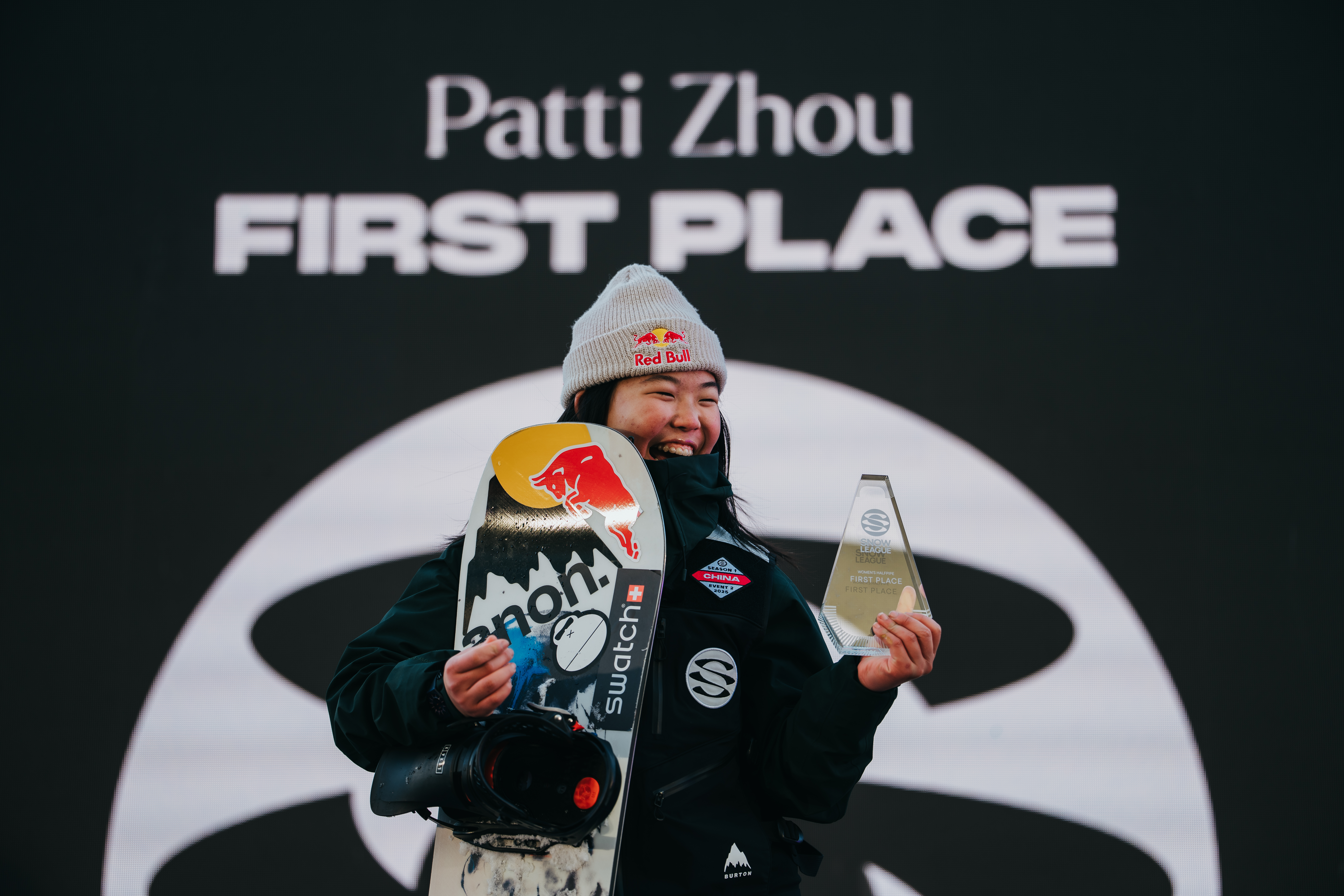Knuckle Huck made its debut at X Games Aspen in 2019. Nine riders, including Red Gerard, Rene Rinnekangas, Nik Baden, Kevin Backstrom, and Fridtjof Tischendorf (who would win gold at that first event) were on the start list. It piqued immediate interest, both for riders and for fans, and in 2020 the event was further cemented as eight riders took to the Aspen stage, including Ryo Aizawa, Halldor Helgason, and now-perennial Knuckle Huck favorites Zeb Powell and Marcus Kleveland (ski also was added to the Knuckle Huck line up with its own event in 2020). That year, as an X Games rookie, Zeb won gold.
Every year since the first, Knuckle Huck has been an audience favorite.
Part of Knuckle Huck’s excitement as an X Games event is that it isn’t only the domain of competitors already immersed in slopestyle or halfpipe (though yes, slope riders are heavy in the lineup overall). The distinctive event is a yearly fulcrum for bringing new riders onto the X Games stage; the only prerequisite is that they possess uncanny board control and a creative way of looking at the part of a jump not usually hit. Riders of all stripes have excelled: Dusty Henricksen, Miles Fallon, Zeb, Ryo, Fridge, Kleveland, and more have been fan favorites over the years.
But while men’s snowboard Knuckle Huck was a hit from the start, there has not yet been a women’s counterpart to date. Jamie Anderson competed in 2021 as the lone woman rider going toe-to-toe with Sebbe de Buck, Marcus Kleveland, and eventual gold medalist Dusty Henrickson. But one woman, even one of the strongest and most impactful contest riders of all time, does not a women’s category make. And the past two iterations of Knuckle Huck have been a men’s-only field.
This year, that changes. Today, X Games announced that Women’s Snowboard Knuckle Huck will debut at Aspen in January 2024, ushering in a new platform for women within a playing field that has historically grown exposure, spurred progression, and offered definitive opportunity. (Women’s Ski Knuckle Huck will also make its debut.)
“X Games is constantly having conversations with athletes and watching the industry landscape more generally, looking for new, exciting disciplines to bring into the fold. Disciplines that both push the progression and the scopes of the sports, which is what X Games is known for, but also disciplines that bring the athletes’ creativity and expression to the forefront,” says Cara Williamson, VP of marketing and brand strategy at X Games, giving ample credit to the team that has brought this Aspen addition to fruition. “Introducing Snowboard Knuckle Huck in 2019 and Ski in 2020, they hit the ground running and very quickly became obvious favorites for both the athletes and the fans. 2024 felt like the perfect time to bring in the women’s disciplines and really round out the offering.”
Since its inception in Rhode Island 1995 (Winter X began in 1997), X Games has always changed up its disciplines in parallel evolution to the action sports it champions. While halfpipe and slopestyle are the mainstays of Winter X, events that bring in riders with additional specialties have continuously evolved throughout the years, whether it’s Real Snow, Snowboard Street, the method contest (opportunity for women riders in these arenas has fluctuated depending on event), or now, Knuckle Huck.
Of course, X Games has been a lauded proving ground for decades. It’s arguably action sports’ brightest competitive stage—both literally and figuratively. A place where gassed-up moments of NBDs are stamped in snowboarding’s history. The course builds are immaculate, the invited riders flush with talent, and the risk/reward ratio high and exciting. This creates the setting for new trick variations, perfect scores, medal records—the stuff of snowboarding legend, not to mention sport progression.
This formula has been routinely proved. Year after year, Aspen is the place where the bar is raised. And year after year, the audience has watched as whenever the women are provided the same playing field as their male counterparts, they have risen to the occasion. Just watch the course of Women’s Big Air since it was brought to X Games Aspen in 2017. The year prior, the riders were ready. Men’s Big Air had been ongoing since 2010. In 2017, Anna Gasser, Jamie Anderson, Julia Marino, and Hailey Langland (Hailey would win gold, with Anna in second and Julia in third) laid the groundwork for what would become a consistent explosion of trick evolution in the coming years.
Famously, Hailey landed a cab double 1080—a trick she had never even tried before practice—to win the inaugural event. Afterward, she told Snowboarder Magazine:
“As soon as I got up there and practice started, a bunch of the girls were already throwing down. I saw Katie do a cab nine…. Definitely going in, I knew I had nothing in comparison to the girls so I was already like, I have nothing to lose. So during practice, I started trying cab nines, and I still can’t do ‘em, but it so happened that one time that I went faster and spun it a little bit harder it just whipped around to cab double ten and I landed straight to my toes and just rode away. I was like, What the hell just happened. It was amazing. From there on I was like, YOLO, might as well just keep doing it. Yeah, I was pretty hyped to put it down in the contest.”
This is the potential of the pressure-cooking, diamond-making machine that is X Games. Watching the way that women riders have blown through the expected when provided the platform to do so (especially the current hyperdrive levels over the better part of the past decade), the advent of their own discipline in Knuckle Huck is something very exciting. Because just having the opportunity is paramount. Women snowboarders have routinely shown that they have more than the qualifications to shine—and the audience to watch them do so is there.
On X Games’ side, the addition is in line with their overarching focus on doing right by the athletes. “X Games has been a leader in the industry for gender parity since its inception,” explains Williamson. “Women’s disciplines have been there since the nineties. We’ve offered equal pay since 2009. And considering that we’re still talking about women’s right to earn equal money, that’s actually quite a significant time.”
The rider list for Women’s Knuckle Huck has yet to be finalized, but the first round of invites has gone out. Ylfa Rúnarsdóttir, Annika Morgan, and Mia Brookes have been invited to compete. In January, eight riders will be on the start list, laying the groundwork for how Women’s Knuckle Huck will evolve in the coming years.
“I think that it is super cool,” Ylfa said about the event being added to Aspen. “Knuckle Huck is so fun to watch and it is a way to show a more grassroots snowboarding to the public. To have a women’s category feels like it should be a given–I mean its 2023 and all the girls are ripping.”
Ylfa’s point about showing this sort of creative snowboarding to a wide audience is a big one. Of course, the inclusion of a Women’s Knuckle Huck competition has the potential for a massive trickle-down effect, as well. Just being shown that something a possibility can influence entire generations. Less than a decade ago, there were hardly any opportunities for female riders to hit a big air jump. Now it’s in X Games, the World Cup circuit, The Olympics. It’s part of the system. And there are more women snowboarders excelling in that arena than ever before.
Yulin Olliver, founder of For Us By Us Sports Agency, has a client list of both established athletes (across skate, surf, and snow) as well as a strong crew of the next generation of pro snowboarders, and deep knowledge about the rising tide effect that a new opportunity like this can have for women. Last year, Yulin started hearing feedback from up-and-comers that “they would enjoy having the option to participate in what’s only ever been a men’s-only event,” she says, adding that the opportunity to bring in women from other areas of snowboarding is loaded with potential to expand visibility for women athletes—and that directly correlates to what the audience takes away from watching what goes down at Aspen.
Knuckle Huck sits at the intersection of transition chops and side hit interpretation, which necessitates a creative perspective that can bring in more competitors from more backgrounds, providing main stage opportunity to riders who may not have had that within the previously existing X Games events. This creates a further aspirational touchpoint for the audience. “Knuckle Huck also stands out because of its low barrier to entry,” adds Olliver. “Maybe a kid learning to snowboard doesn’t have a good pipe—or any halfpipe at all—at her home resort. But every resort has a knuckle, or a cat track, or a step-down situation. The creativity seen off a knuckle defies all labels; any type of snowboarder is going to love hucking off the knuckle of a well-built jump. It brings us all back together to our foundation as snowboarders, built on the unrelenting pursuit of fun, air, flying, and the artistry that is our boards on the snow in our self-expression.”
Young riders have been fully inspired by Kleveland, Powell, Tischendorf, and Helgason. By Powell and Fallon. And by Anderson. Now, what will young girls dream when they watch the women do their thing in their own event on a massive stage? When they watch Ylfa, Annika, Mia, and more raise the bar on the knuckle? Perhaps that is the most exciting thing of all and the women who drop in this January will set the pace for what’s to come.






